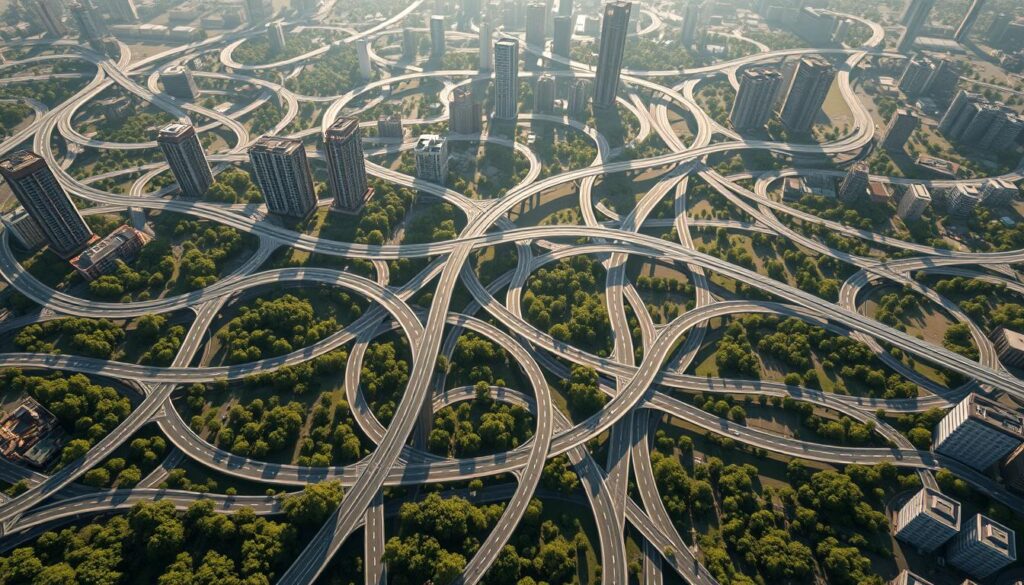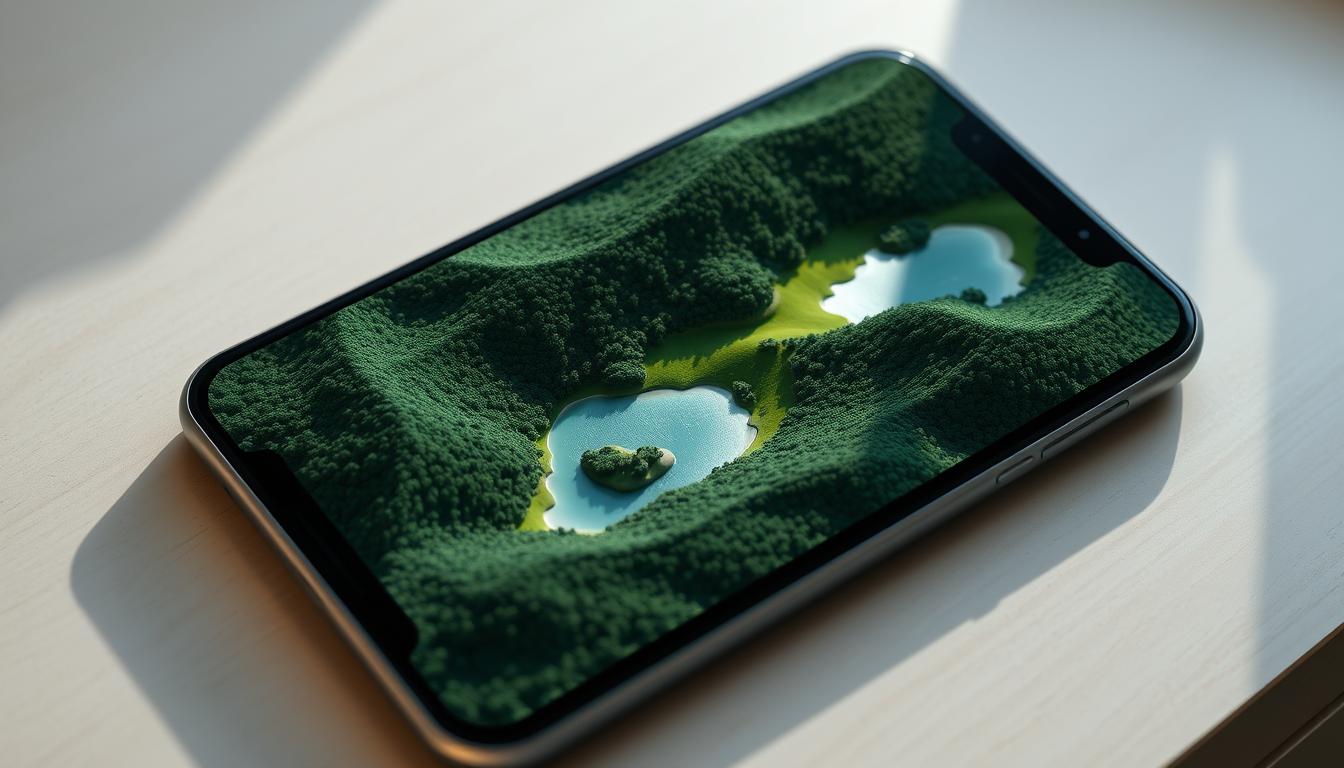Ever wondered how your favorite mobile games create cities that feel real and immersive? The answer is procedural generation. This technique optimizes road networks to make games more engaging. As mobile gaming grows, knowing how to create dynamic environments is key for developers.
We’ll look at different methods and algorithms for making vast urban areas. You’ll see how procedural generation changes our virtual city experiences.
Introduction to Procedural Road Network Generation
Procedural road generation is a new way to make urban mobile games. It uses advanced algorithms to create complex road networks easily. This makes games more varied and dynamic, offering a unique experience for players.
Understanding the algorithms behind procedural generation is key. Techniques like fractals and noise functions help shape street layouts. These methods automate road creation and add a unique twist to each game.
As urban mobile games grow, so does the need for procedural road generation. It helps developers build detailed cityscapes that attract many players. By avoiding repetition, these algorithms make games more exciting and immersive.

The Importance of Procedural Generation in Urban Mobile Games
Procedural generation is key in urban gaming. It changes how we create game worlds, making them unique and alive. This method helps developers work faster and makes games more exciting for players.
It lets developers create endless worlds. This means players always face new challenges and see different things. It makes games more fun because each time you play, it’s different.
Procedural generation started with roguelike games. These games used random elements to add surprise and fun. Now, it’s used in many games, making them more engaging.
Today’s games use advanced tech to make cities feel real. They focus on how players interact with the game world. This makes the game worlds bigger and more personal, connecting players to their virtual homes.

Understanding Urban Infrastructure in Game Design
Urban infrastructure is key in mobile games, covering roads, utilities, and buildings. Developers focus on it to make cities engaging and useful. They use real-world urban planning to make virtual cities feel real.
Procedural urban planning makes cities dynamic and immersive. It makes moving around and managing resources feel natural. Players enjoy exploring these well-designed cities, thanks to urban planning.
Noise Algorithms for Natural Terrain Generation
Noise algorithms are key in making urban environments feel real. Perlin noise is a top choice for creating natural-looking textures. It helps in designing roads and adding depth to the terrain.
Perlin Noise in Road Network Design
Perlin noise makes road networks look more natural. It creates a smooth flow of values, making roads feel part of the landscape. This approach makes each urban area unique and immersive.
Other Noise Functions and Their Applications
Simplex and fractal noise are also used for terrain. They add complexity and variety to urban landscapes. Using different algorithms, developers can create detailed and engaging environments.
Using L-Systems for Dynamic City Planning
L-systems, or Lindenmayer systems, are a new way to design cities in urban mobile games. They are great for making different parts of a city. This helps developers create exciting and detailed places for players to explore.
Generating Modular Buildings and Vegetation
Developers use L-systems to make buildings and plants fit together well. This makes cities look better and makes designing cities easier. Buildings can look different, and plants add life to the city.
Creating Varied City Landscapes through Rules
L-systems use rules to make cities look different every time. These rules help buildings and plants work together in new ways. Players see a city that changes and offers new things to do every time they play.
| Element | Functionality | Impact |
|---|---|---|
| Modular Buildings | Constructed from L-systems rules | Enhances architectural diversity |
| Vegetation | Integrates with building designs | Increases environmental realism |
| Dynamic Rule Sets | Modulates city design | Ensures unique layouts and player engagement |
Dungeon Generation Techniques Applied to Urban Layouts
Mobile game developers can use dungeon generation techniques to improve urban layouts. These methods help create engaging environments. Two key techniques are cellular automata and BSP urban design. They help make urban landscapes that players love.
Cellular Automata for Road and Path Creation
Cellular automata are great for making complex road networks. They work on a grid, where each cell interacts with its neighbors. This creates varied road patterns, making the urban experience more realistic.
This method leads to dynamic designs. These designs can change based on the environment or game needs.
BSP (Binary Space Partitioning) Methods in Urban Design
BSP urban design is a systematic way to divide spaces. It’s perfect for organizing city areas. By dividing spaces into two parts, it creates a tree structure of nodes.
This technique helps organize city areas well. It makes the urban layout efficient. It supports different architectural styles and road setups.
Rule-Based Systems for Controlled Generation
Rule-based systems are key in handling the complexity of urban procedural generation. They let developers set rules, leading to well-designed urban areas. This makes the game more fun and immersive.
The rules chosen affect many game aspects. This includes how resources are used and how players interact with the game world.
Defining Parameters for Urban Infrastructure
Setting clear parameters is vital for urban game design. These rules help create beautiful and engaging urban elements. They guide the building process, leading to organized layouts.
This method uses a systematic approach. It ensures each part of the environment follows the game’s rules.
Ensuring Fair Resource Distribution
Fair resource management is crucial for game balance. Rule-based systems help distribute resources fairly among players. This prevents unfairness that could make players unhappy.
By setting rules for resource use, developers ensure everyone has a fair chance. This makes the game more enjoyable and fair for all players.
Procedural Asset Generation in Mobile Games
Procedural asset generation is key in making mobile games more real and varied. It helps developers make things like roads, buildings, and traffic systems automatically. This makes games more unique and fun.
By using algorithms, developers can make different and detailed urban areas. These areas can change based on the game, making it more exciting.
Creating Roads, Buildings, and Traffic Systems
Using procedural methods for roads, buildings, and traffic makes game development better. Algorithms help create detailed road networks that fit well with the city. Buildings come in different styles and sizes, adding to the game’s look.
Traffic systems can act like real traffic, making the game more challenging. This adds a strategic layer to the gameplay.
Texture Generation for Urban Environments
Texture generation adds depth and realism to urban areas in games. Procedural methods help create high-quality textures. These textures make the game world look better and more real.
By making textures that change with the game, developers can keep the look consistent. This makes the game more enjoyable and immersive.
Innovative Approaches to Optimized Urban Infrastructure Procedural Generation
New ways to improve urban environments in mobile games have emerged. These methods make creating cities more efficient and detailed. They use algorithms that blend machine learning and design to make cities feel alive.
Hybrid algorithms mix old and new techniques to create detailed cities. They make roads and buildings that change with the player’s actions. This makes games more fun and looks better on different phones.
Data-driven design is another key method. It uses real city plans to make game worlds feel real. This approach makes games more engaging and realistic, showing what’s possible with procedural generation.
Machine Learning Techniques for Enhanced Generation
Technology keeps getting better, making machine learning in gaming more important. It helps improve how games are made. By using Generative Adversarial Networks (GANs) and reinforcement learning, games can feel more real and exciting. These new ways of making games let developers keep up with what players want.
Using Generative Adversarial Networks (GANs)
Generative Adversarial Networks (GANs) are a big deal in making games better. They help create unique art and textures. GANs work by having two neural networks compete, making game elements look real.
This makes games look better and gives players something new every time they play.
Reinforcement Learning in Urban Game Development
Reinforcement learning is key in making urban games better. It helps games understand how players behave and improve the game. This way, games can get better over time, making players happier and more engaged.
Search-Based Methods for Optimized Design
Search-based methods are key in urban planning for mobile games. Monte Carlo Tree Search is a top tool for planning routes. It uses a random approach to check many paths, going beyond simple algorithms.
This method changes with the game, making paths both fast and flexible. It adapts to new situations, keeping routes efficient and responsive.
Monte Carlo Tree Search in Route Planning
Monte Carlo Tree Search is known for its ability to try many paths in urban layouts. It uses random choices to find the best routes. This makes it perfect for complex city designs where other methods fail.
Players get routes that feel real and fun. This makes their game experience much better.
Evolutionary Algorithms for Adaptive Road Systems
Evolutionary algorithms improve city layouts by using natural selection. They make road systems better over time, enhancing gameplay. By trying different road setups, they find the best ones for players.
This keeps the game world fresh and exciting. It makes sure the city design stays fun and engaging.
Wave Function Collapse Algorithm in Urban Game Context
The Wave Function Collapse (WFC) algorithm is a game-changer for making cities in games. It makes creating detailed city maps easy while keeping them looking good. It works by using tiles, letting developers set rules for each one. This leads to cities that look real and are full of life.
Generating Complex City Grids with Ease
Creating city maps can be hard for game makers. WFC makes it easier by breaking down cities into smaller parts called tiles. These tiles are then put together based on rules. This way, developers can make detailed cities without spending too much time.
WFC makes cities look different and real. This makes it perfect for urban mobile games.
Advantages of WFC in Procedural Generation
Using the Wave Function Collapse algorithm has many benefits. Some key advantages include:
- Efficiency: WFC saves time and resources by automating city map creation.
- Detail Retention: It makes cities look good and detailed, keeping players interested.
- Flexibility: Developers can change tile sets and rules easily. This lets them create different city designs for various game stories.
- Consistency: WFC makes sure city maps are logical. This improves the game experience.
By using the Wave Function Collapse algorithm, developers can make urban experiences that grab players’ attention. This boosts the game’s overall performance.
Balancing Performance and Visual Fidelity
In urban mobile games, developers must balance performance with visual quality. They use LOD techniques to make graphics look good without slowing down the game. These methods change how detailed graphics are based on how close the player is.
Level of Detail (LOD) Techniques in Procedural Cities
LOD techniques are key for better performance in procedural cities. They use simpler models far away and more detailed ones up close. This keeps the game looking great while using system resources wisely.
Optimizing Memory Management for Mobile Platforms
Good memory management is vital for a smooth game. Using texture atlases and smart memory allocation helps a lot. These methods make accessing game assets fast and cut down on loading times, boosting performance without losing visual quality.
| Technique | Description | Benefits |
|---|---|---|
| LOD Techniques | Adjusts visual detail based on proximity to the player. | Enhanced performance without losing visual quality. |
| Texture Atlases | Combines multiple textures into one to minimize draw calls. | Improved rendering speed and lower memory usage. |
| Memory Pooling | Reuses allocated memory for dynamic objects. | Reduces fragmentation and improves performance efficiency. |
Evaluation Metrics for Procedural Generation Quality
Evaluation metrics are key to judging the quality of procedural generation in urban mobile games. They help developers see how well the game meets player needs. By using these metrics, developers can make the game more engaging and visually appealing.
Assessing Player Engagement and Experience
Developers can use metrics like retention rates, session length, and user interactions to measure player experience. These metrics show how players interact with the game world. This information helps developers improve the game, making it more enjoyable for players.
Determining Aesthetic Quality through Metrics
Metrics like visual diversity, coherence, and appeal are crucial for evaluating the game’s looks. They help developers understand if the game’s visuals are engaging. A good procedural system should be both functional and visually stunning, creating a deep gaming experience.
| Evaluation Metric | Player Engagement | Aesthetic Quality |
|---|---|---|
| Retention Rate | Tracks recurring gameplay | N/A |
| Session Length | Measures time spent in-game | N/A |
| User Interactions | Counts actions taken by players | N/A |
| Visual Diversity | N/A | Assesses the variety of visual elements |
| Coherence | N/A | Measures how well the visuals work together |
| Overall Appeal | N/A | Gauges general attractiveness of the environment |
Case Studies: Successful Implementation of Procedural Techniques
Many case studies show how procedural generation works well in urban game design. Developers use different methods to make engaging environments. For example, CityEngine helps create detailed urban layouts by automating road and building placements.
No Man’s Sky is another great example. It uses procedural generation to create a huge universe. Each planet has its own terrain, biomes, and ecosystems. This method saves time and keeps things diverse, showing its power in creating both urban and fantastical worlds.
Looking at these case studies, we see some key benefits:
| Case Study | Methodology | Challenges Faced | Solutions Implemented |
|---|---|---|---|
| CityEngine | Modular Generation | Complexity in layout | Automated layout tools |
| No Man’s Sky | Procedural Planetary Generation | Maintaining variety | Dynamic algorithm adjustments |
| SimCity | Rule-Based Systems | Resource imbalance | Dynamic adjustments |
These procedural generation implementations inspire game developers. They show how new techniques can solve design problems and boost creativity in urban game design. Using these methods makes game development easier and more exciting for players, proving procedural generation is a powerful tool.
The Future of Procedural Generation in Urban Mobile Games
The world of urban mobile games is changing fast. New trends and technologies are leading the way. Developers are using new methods to make games better, offering more exciting experiences.
Emerging Technologies and Their Potential Impact
Technologies like artificial intelligence and machine learning are changing game making. They help create game worlds that change as you play. This makes games more fun and personal for each player.
Developing Personalized Game Experiences through Procedural Techniques
Procedural generation makes games feel more personal. It lets players see their own world in the game. By using what players like, games can become even more special and fun.
Conclusion
Optimized procedural road network generation is key for better urban mobile gaming. This article explored various techniques, like noise algorithms and machine learning. These strategies help create lively, engaging worlds.
They make it possible to build complex cities instantly. This not only makes games more fun but also lets developers create unique stories.
Looking ahead, new technologies will make procedural methods even better. Advances in algorithms like generative adversarial networks promise more interactive city-building. Developers should use these tools to keep procedural generation important in urban mobile games.
Optimized procedural techniques are very important. They make games more fun and easier to design. By using these methods, developers can create unforgettable gaming experiences. This is an exciting time for both developers and players.
FAQ
What is procedural road network generation?
Procedural road network generation uses algorithms to create roads in games. It makes game development faster. It also lets developers make different urban landscapes.
How does procedural generation enhance player engagement in urban mobile games?
It makes games more engaging by offering varied environments. This leads to unique challenges and visuals. It boosts replay value and keeps players interested.
What algorithms are commonly used for procedural generation in urban game design?
Developers use Perlin and Simplex noise for visual effects. L-systems create organic designs. Cellular automata simulate roadways. Monte Carlo Tree Search (MCTS) plans routes.
How do L-systems contribute to procedural generation in mobile games?
L-systems help create complex structures like buildings and plants. They add variety to cityscapes. This makes games look better and more interesting.
What role does machine learning play in procedural generation?
Machine learning, like GANs and reinforcement learning, changes procedural generation. It makes unique art and improves environments based on player feedback.
How do noise algorithms like Perlin noise affect terrain generation?
Perlin noise creates natural-looking terrain. It makes landscapes smooth and realistic. This adds to the game’s feel and look.
What are the challenges in maintaining visual fidelity in mobile games?
Keeping games looking good on mobiles is tough. Developers use Level of Detail (LOD) and manage memory. This ensures games run smoothly.
What factors are essential for setting up rule-based systems in procedural generation?
Important factors include setting resource rules and balancing gameplay. It’s also crucial to keep game mechanics consistent in the generated urban space.
What are some successful case studies of procedural generation in urban mobile games?
Many case studies show how procedural generation works. They highlight methods used and challenges faced. They show how to create engaging urban environments.
What future trends are anticipated in procedural generation for mobile gaming?
AI and machine learning will play a bigger role. They will make games more personal. This will lead to customized urban environments in mobile games.




